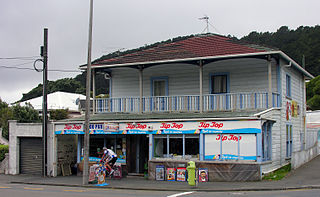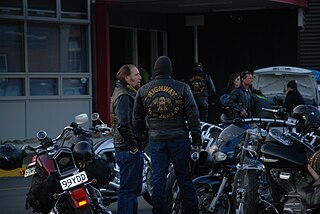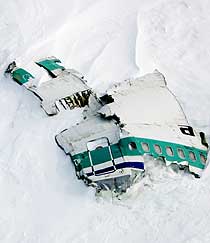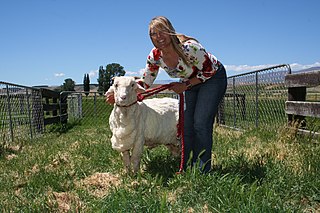 W
WThe culture of New Zealand is essentially a Western culture influenced by the unique environment and geographic isolation of the islands, and the cultural input of the indigenous Māori people and the various waves of multi-ethnic migration which followed the British colonisation of New Zealand.
 W
WThe Anzac spirit or Anzac legend is a concept which suggests that Australian and New Zealand soldiers possess shared characteristics, specifically the qualities those soldiers allegedly exemplified on the battlefields of World War I. These perceived qualities include endurance, courage, ingenuity, good humour, larrikinism, and mateship. According to this concept, the soldiers are perceived to have been innocent and fit, stoical and laconic, irreverent in the face of authority, naturally egalitarian and disdainful of British class differences.
 W
WA bach is a small, often modest holiday home or beach house in New Zealand. Baches are an iconic part of the country's history and culture. In the middle of the 20th century, they symbolized the beach holiday lifestyle that was becoming more accessible to the middle class.
 W
WThe Bombay Hills are a range of hills to the south of Auckland, New Zealand. Though only a small and seemingly insignificant range of hills, they lie at the southern boundary of the Auckland region, and serve as a divide between Auckland and the Waikato region. There is a 19th-century settlement, Bombay, on the old main road south of Auckland, the Great South Road.
 W
WThe Buzzy Bee is a popular toy in New Zealand. It resembles a bee with rotating wings that move and make a clicking noise while the toy is pulled along the ground. Possibly based on an earlier American concept, it was designed and first produced in Newton, Auckland in the 1930s, by Maurice Schlesinger. It became popular during the post-war baby boom. Its bright colours and clicking sound call are familiar to many New Zealanders, making it one of the most well-recognised items of Kiwiana. Since this time however, the Buzzy Bee has branched out into various merchandise including books, puzzle and clothing.
 W
WCathedral is a two-player abstract strategy board game in which two factions vie for territorial supremacy within the bounds of a medieval city. The game is produced by Chrisbo I.P. Holdings Limited in New Zealand.
 W
WA chatter ring is a New Zealand toy ring of thick metal wire with several beads. The toy is used by swiping the beads to get them spinning, while keeping the ring turning. Around fifty thousand rings were purchased in New Zealand at department stores, street markets and dairies in 1996, and was a popular Christmas gift for children that year. During this time, there were several mentions of chatter rings on both radio and television.
 W
WThe culture of the Cook Islands reflects the traditions of its fifteen islands as a Polynesian island country, spread over 1,800,000 square kilometres (690,000 sq mi) in the South Pacific Ocean. It is in free association with New Zealand. Its traditions are based on the influences of those who settled the islands over several centuries. Polynesian people from Tahiti settled in the Cook Islands in the 6th century. The Portuguese captain, Pedro Fernandes de Queirós, made the first recorded European landing in the islands in the early 17th century, and well over a hundred years later, in the 18th century, the British navigator, Captain James Cook arrived, giving the islands their current name. Missionaries developed a written language, bringing schools and Christianity to the Cook Islands in the early 19th century. Cook Islands Māori, also known as Māori Kūki 'Āirani or Rarotongan, is the country's official language.
 W
WCookie Bear, otherwise known as CB, is a familiar character in New Zealand originally associated with Hudsons and now Griffins biscuits. Cookie Bear's popularity grew with New Zealand children through the Cookie Bear Club, their shared love of Chocolate Chippies and his famous catchphrase Dum-de-doo.
 W
WA dairy is a small owner-operated convenience store in New Zealand, licensed to sell groceries, milk, eggs, dairy products, perishables, newspapers and other staples during and after normal trading hours.
 W
W"For the Fallen" is a poem written by Laurence Binyon. It was first published in The Times in September 1914.
 W
WA gang patch in New Zealand refers to the identifying insignia of a street gang. Patches have been linked to intimidation of members of the public by gang members. Gang patches perform much the same identification role as gang colours do in other countries.
Ira Goldstein is a fictional character played by Stephen Mellor, who appears in television and radio commercials for ASB Bank in New Zealand. The commercials were screened from January 2000 to October 2010 and were produced by TBWA / Whybin agency.
 W
WA hei matau is a bone or greenstone carving in the shape of a highly stylised fish hook typical of the Māori people of New Zealand. They represent good luck and safe travel across water.
 W
WHousetruckers are individuals, families and groups who convert old trucks and school buses into mobile homes and live in them, preferring an unattached and transient lifestyle to more conventional housing. These vehicles began appearing around New Zealand during the mid-1970s and, even though there are fewer today, they continue to travel New Zealand roads.
 W
WKia kaha is a Māori phrase used by the people of New Zealand as an affirmation, meaning stay strong. The phrase has significant meaning for Māori: popularised through its usage by the 28th Māori Battalion during World War II, it is found in titles of books and songs, as well as a motto.
 W
W"Kiwi" is a common self-reference used by New Zealanders, though it is also used internationally. Unlike many demographic labels, its usage is not considered offensive; rather, it is generally viewed as a symbol of pride and endearment for the people of New Zealand. The name derives from the kiwi, a native flightless bird, which is a national symbol of New Zealand. Until the First World War, the kiwi represented the country and not the people; however, by 1917, New Zealanders were also being called "Kiwis", supplanting other nicknames such as "Enzedder".
 W
WThe McGillicuddy Highland Army is the fighting wing of New Zealand's Clan McGillicuddy and does battle with enemies of the Clan in accordance with the rules of the pastime of pacifist warfare. Battles have taken place at wide range of locations and events around the country. During the period 1984-1999 it shared many members in common with the Clan's political wing, the better-known McGillicuddy Serious Party.
 W
WNaturism refers to a lifestyle of practising non-sexual social nudity in private and in public, and to the cultural movement which advocates and defends that lifestyle. Both are also known as "nudism". Naturist organisations have existed in New Zealand since the 1930s. Although not a daily feature of public life, social nudity is practised in a variety of other contexts in New Zealand culture.
 W
WThe New Zealand dream centres on the acquisition of a family house on a quarter-acre section, with at least one motor vehicle. The New Zealand dream resembles the Australian Dream. For many New Zealanders this dream could also include a pleasure boat, a bach and a holiday at the beach.
 W
WNumber 8 wire is a 0.16"-diameter gauge of wire on the British Standard Wire Gauge that has entered into the cultural lexicon of New Zealand.
 W
WThe Mount Erebus disaster occurred on 28 November 1979 when Air New Zealand Flight 901 (TE-901) flew into Mount Erebus on Ross Island, Antarctica, killing all 237 passengers and 20 crew on board. Air New Zealand had been operating scheduled Antarctic sightseeing flights since 1977. This flight was supposed to leave Auckland Airport in the morning and spend a few hours flying over the Antarctic continent, before returning to Auckland in the evening via Christchurch.
 W
WThe Paua House was a tourist attraction in the southern New Zealand town of Bluff, but now on display at the Canterbury Museum in Christchurch.
 W
WThe University of Otago is a collegiate university based in Dunedin, Otago, New Zealand. It scores highly for average research quality, and in 2006 was second in New Zealand only to the University of Auckland in the number of A-rated academic researchers it employs. In the past it has topped the New Zealand Performance Based Research Fund evaluation.
 W
WSheep shearing is the process by which the woollen fleece of a sheep is cut off. The person who removes the sheep's wool is called a shearer. Typically each adult sheep is shorn once each year. The annual shearing most often occurs in a shearing shed, a facility especially designed to process often hundreds and sometimes more than 3,000 sheep per day.
 W
WSheep farming or sheep husbandry is the raising and breeding of domestic sheep. It is a branch of animal husbandry. Sheep are raised principally for their meat, milk, and fiber (wool). They also yield sheepskin and parchment.
 W
WShrek was a Merino wether belonging to Bendigo Station, a sheep station near Tarras, New Zealand, who gained international fame in 2004, after he avoided being caught and shorn for six years. Merinos are normally shorn annually, but Shrek apparently hid in caves, avoiding muster. He was named after the fictional ogre in books and films of the same name.
 W
WSirocco is a kakapo, a large, flightless, nocturnal parrot, and one of the 205 remaining kakapo in the world. He achieved individual fame following an incident on the BBC television series Last Chance to See in which he attempted to mate with zoologist Mark Carwardine. Subsequent featuring of the incident on television channels around the world and on YouTube resulted in Sirocco becoming internationally known. In his home country of New Zealand, Sirocco has attracted thousands of people during "personal" appearances, and in January 2010 was given the title of Official Spokesbird for Conservation by Prime Minister John Key. In this role, Sirocco helps advocate for conservation through human intermediaries on social media sites and blogs.
 W
WThe six o'clock swill was an Australian and New Zealand slang term for the last-minute rush to buy drinks at a hotel bar before it closed. During a significant part of the 20th century, most Australian and New Zealand hotels shut their public bars at 6 pm. A culture of heavy drinking developed during the time between finishing work at 5 pm and the mandatory closing time only an hour later.
 W
WIn New Zealand, the southern man is a stereotypical male from the more rural South Island, well used to the solitude and conditions of open mountain or hill country, and completely out of his depth in the city. He is usually depicted as wearing an oilskin duster, Swanndri and slouch hat, an image closely related to Kiwi stockmen. This stereotype is closely connected with a common trope in New Zealand fiction, the man alone.
 W
WTramping, known elsewhere as backpacking, rambling, hill walking or bushwalking, is a popular activity in New Zealand.
 W
WThe Undie 500, originally named the Under 500, was an annual student-run car rally between Christchurch and Dunedin, New Zealand with multiple stops at drinking establishments along the way. The name comes from the original rule that a vehicle is purchased for less than NZ$500, and optionally decorated.
 W
WWelly throwing, also known as welly hoying, welly wanging and boot throwing, is a sport in which competitors are required to throw a Wellington boot as far as possible. The sport appears to have originated in the West Country of England in the 1970s, and rapidly became a popular activity at village fêtes and fundraising events across Britain. The sport is now played in many different countries, including Australia, Estonia, Finland, Germany, Ireland, Italy, New Zealand and Russia.
 W
WThe phrase "world famous in New Zealand" is a commonly used phrase within New Zealand and the slogan of Lemon & Paeroa soft drink. It is used to describe items that though famous within New Zealand are unknown in the rest of the world, whereas similar items and people in larger countries would have a far higher media profile and would therefore be famous worldwide.